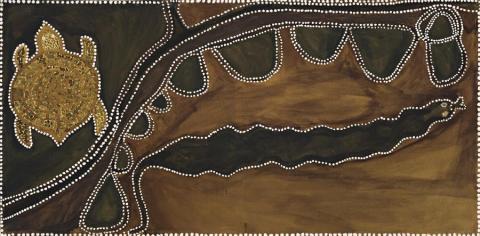KUNUNURRA BRIDGE, 1986
Rover Thomas (Joolama)
natural earth pigments and natural binder on canvas
90.0 x 180.0 cm
inscribed verso: RT1086 TRRRR
Mary Macha, Perth (cat. 224)
Lauraine Diggins Fine Art, Melbourne (label attached verso)
Private collection, Queensland
19th and 20th Century Australian Painting, Sculpture and Decorative Arts, Lauraine Diggins Fine Art, Australian Antique and Fine Art Dealers Fair, Sydney 14—18 May 1997, and Lauraine Diggins Fine Art, Melbourne, 31 May—28 June 1997, p. 43 (illus.), cat. 76
Railway Bridge, Katherine, 1984, collection of the National Gallery of Victoria, in Ryan, J., Images of Power: Aboriginal Art of the Kimberley, National Gallery of Victoria, Melbourne, 1993, pp. 58-59 (illus.)
Texas Downs Country, Deutscher~Menzies, Melbourne, 20 April 1998, lot 6
Kununurra Bridge, Sotheby's, 28—29 July 2003, lot 124
The original catalogue card from Mary Macha notes that Kununurra Bridge 1986 depicts 'Water with turtle and a salt water snake (python). A similar python or snake to this killed a little boy'
The painting of Rover Thomas was not confined to the recollection of his country and dreaming but also incorporated historical events or the relating of local oral culture. On board or canvas, Thomas functioned as illustrator and storyteller, seeing his paintings as landscapes but not static records, rather as living portraits of land incorporating the physical, historic and metaphysical; the present and the past. His subject matter was not limited to his land. As Mary Macha remembered 'He'd paint what he wanted to paint; his country, the East Kimberley, Perth, Katherine, Broome country all over the place.'1
Similar to the artist's other depictions of landmarks such as Kimberley Crossroads 1990, Railway Bridge, Katherine 1984 or Swan River 1991, Kununurra Bridge 1986 holds layers of meaning with history, mythology and lived experience all incorporated in the narrative. The painting integrates elements of geography, (Kununurra Bridge and Road), mythological dreaming sites (Turtle and Python) and recent history (the death of the little boy killed by a python). Thomas's record of place is infused with history both domestic and mythological and his palette is derived from the Kimberley landscape, mapping out the land and its stories in the deep brown and yellow ochre of the Kimberley topography.
Stylistically, Kununurra Bridge 1986, highlights the distinctive characteristics of Thomas's painting, exemplifying the artist's two modes of representation that converge into one. While a planar view depicts road, bridge and flattened country, profile views describe Kimberley landscape features and in this example mythological subjects are rendered realistically. Thomas used his deeply personal vision to redefine the pictorial conventions of the region. Minimal in composition yet complex in meaning, here history, mythological knowledge and lived experience that underpin much Aboriginal art are simultaneously represented. As curator Hetti Perkins has noted 'nowhere has the merging of the past and present, the spiritual and physical been more clearly realised than in Thomas's paintings.'2
Rover Thomas began to paint in the mid 1970s after working for more than thirty years as a stockman and labourer in his home country of the Great Sandy and Gibson Deserts. By the mid 1980s his work had been represented in many group exhibitions and was increasingly recognised as an accomplished and distinguished artist. In 1990 he was selected to represent Australia at the Venice Biennale and he has been the subject of two important solo exhibitions, Roads Cross: The Paintings of Rover Thomas, National Gallery of Australia, Canberra in 1994 and I Want to Paint, a traveling exhibition touring nationally from 2003 to 2005. In 1997, the University of Western Australia awarded him an honorary doctorate in recognition of his artistic contribution.
1. Mary Macha and Don McLeod interviewed by Duncan Peppercorn March 2003, Rover Thomas; I Want to Paint, exhibition catalogue, Heytesbury Pty Ltd, East Perth, 2003, p. 51 2. Perkins, H. Traditions Today; Indigenous Art in Australia, Art Gallery of New South Wales, Art Gallery of New South Wales 2004, p. 134
